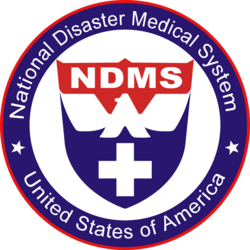
The National Disaster Medical System (NDMS) is a federally coordinated disaster medical system and partnership of the United States Departments of Health and Human Services (HHS), Homeland Security (DHS), Defense (DOD), and Veterans Affairs (VA). The purpose of the NDMS is to support State, local, Tribal and Territorial authorities following disasters and emergencies by supplementing health and medical systems and response capabilities. NDMS would also support the military and the Department of Veterans Affairs health care systems in caring for combat casualties, should requirements exceed their capacity.[1] The NDMS was established in 1984.
The Department of Health and Human Services, Administration for Strategic Preparedness and Response (ASPR), in its role as Coordinator of Emergency Support Function#8 (ESF-8), Public Health and Medical Services, of the National Response Framework (NRF), employs the NDMS to provide patient care, patient movement, and definitive care, as well as veterinary services, and fatality management support when requested by authorities from States, localities, Tribes and Territories, or other federal departments. Some common missions for NDMS include: augmenting a hospital in a disaster area to decompress the overtaxed emergency department; providing veterinary services to federal working animals during National Security Special Events, such as the Presidential Inauguration; and, supporting the National Transportation Safety Board and affected localities with fatality management services following major transportation disasters. Although NDMS is primarily a domestic disaster response capability, NDMS teams and personnel have also been deployed to disasters internationally, such as in Iran and Haiti following devastating earthquakes.
- ^ "National Disaster Medical System". HHS. Retrieved October 21, 2016.
© MMXXIII Rich X Search. We shall prevail. All rights reserved. Rich X Search
